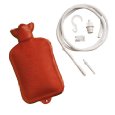What to Put Into an Enema and Why
Enema Tips and Tricks on Preparation:
After all my extensive research and sifting through volumes of information, these are the types of enemas that came up as being used in the healing world and some common tips I found in various resources. I’ve also added in some tips and tricks I’ve gleaned from experimenting with enemas on my own that I think will best serve you.
One benefit of muscle testing is that you can test out a schedule to fit your enema needs exactly. That means what types of enemas to use, their strength and how often to do them.
- Burdock root is a good blood purifier and is good for skin problems, improved kidney function and helps the body eliminate calcium deposits.
- Castor Oil Enemas: If chronic constipation or impaction is an issue, add in a tablespoon of castor oil to the enema.
- Catnip has a soothing effect on the body and is good for energy. It improves circulation, is excellent for colds, fever and gas.
- Green Juice enemas are routinely added when treating cancer patients. The juices for this enema include watercress, parsley, dandelion leaves and wheat grass juice.
- Herbal Enema Solutions: Use 1 teaspoon dry herb per gallon of water or 1 tablespoon fresh, chopped herb; bring to boil then let cool to body temperature.
- Lemon juice enemas are made with one pint of water and the juice of ½ of a fresh lemon. Lemon juice enemas are especially good for colitis problems.
- Red Raspberry Leaf is good for all kinds of female problems. Red raspberry leaf is high in iron, good for the eyes and for elimination and is very nutritious.
- Yarrow is good for the liver, stomach and glands. It is also a blood purifier opening the pores of the skin by acting as a diaphoretic (something that makes one sweat). It is good for colds, cramps, fever and flu.
Other single herbs used in enemas have included Blessed Thistle, Plantain, Pleurisy Root, Thyme, Hyssop, Mint, Elder Flower, White Oak Bark, Yellow Dock, Mullein, Echinacea, Dandelion, Parsley, and Marshmallow Root.
If you have cancer, AIDS, malabsorption problems or other serious illnesses adding 1 cc of B-complex or 2 cc liver extract plus a dropperful of liquid kelp or sea water concentrate to the retention enemas will give you an extra boost and help rebuild the liver.
To kill unwanted bacteria in the colon products like Aerobic O7, Dioxychlor, and liquid acidophilus (American Health brand can be found at the health food store in the refrigerator section) can be added to the enemas as well. Be careful of Dioxychlor—it’s potent stuff!
Tips for a More Effective Enema:
- Make sure the enema water is not too cold or too hot. It should be body temperature or slightly above.
- To make enemas the most effective, the patient should lie on their right side with both legs drawn up close to the abdomen. Try to hold the enema in for 5-20 minutes for best results.
- Massaging the abdomen will help dislodge and move fecal material and it also assists in releasing hardened mucus in the intestinal folds.
- Enemas should be continued even after a fast is broken until the bowels begin to move naturally without the help of the enema.
- Copious amounts of debris and ill-smelling waste can come out of the bowels with the enema water even after five weeks of fasting
- Keep all equipment clean and disinfected by washing with soap and water after each use.
Helpful Links and references for Enema Tips and Tricks:
- To read the more in depth discussion about enemas on this website, go to: https://naturalhealthtechniques.com/enemas/
